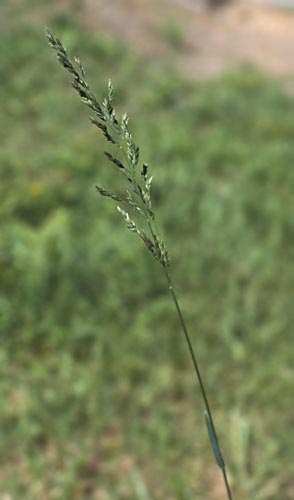Kentucky Bluegrass

Common Name(s):
Kentucky Bluegrass
Scientific Name:
Poa pratensis L.
Scientific Name Synonyms:
None known
Symbol:
POPR
Description:
Life Span: Perennial
Origin: Introduced
Season: Cool
Growth Characteristics: A long-lived sodgrass with rhizomes, growing 6 inches to 3 feet tall. Young shoots are slightly flattened, but seedstalks are round. Growth from the rhizomes is initiated in summer or fall, and aerial culms are initiated in early spring and summer. It becomes dormant during the summer if moisture is limiting. Kentucky bluegrass reproduces from seeds, tillers, and rhizomes.
Seedhead: Open, spreading, pyramidal panicle, 2 to 8 inches long, with panicle branches whorled in groups of 3 to 5; spikelets contain 3 to 5 florets; lemmas awnless but cobwebby-hairy at base.
Leaves: Mostly basal, nearly glabrous; blades V-shaped, narrow, 1 to 7 inches long, with boat-shaped tips and two prominent veins along the center of the upper suface of the leaf which appear as miniature railroad tracks; leaves folded in bud; ligules short, membranous, collars-shaped; auricles absent.
Ecological Adaptions:
Kentucky bluegrass was apparently introduced into North America from Europe in early colonial days. Native North American Indians called it "White mans tracks" because most everywhere white man went with his livestock and plows they found Kentucky bluegrass. Its rapid dispersion was probably related to the cobwebby-hairs on the base of the floret - they cling to most everything they touch.
There is much discussion on whether this plant is native to Utah. It was originally believed to be introduced from Europe, but new evidence suggests that there was a native population present prior to introduction. Whether native or introduced, it is now performing like a native plant, producing 5 to 10 percent of the total vegetation on sites, with amounts varying depending on the site at which it occurs. It is widely distributed from the irrigated valleys, residential lots, golf courses, and on up to the high mountains where rainfall varies from 14 to 28 inches per year.
Not tolerant of drought.
Soils: It grows well on a wide variety of soils but best on deep to moderately deep, well-drained loams and clay loams. It is frequently found on wet soils but does not thrive on acid or saline-alkaline soils. It grows well in Utah in well-developed mountain soils and meadows along watercourses. It is found in the high mountain under aspen and in open areas in the mountains.
Associated Species: Cheatgrass, big sagebrush, smooth brome, Nevada bluegrass, mountain brome.
Uses and Management:
Kentucky Bluegrass provides a dense, green sod, especially well adapted for lawns, beautification, and recreational uses. Its forage value is good for livestock and wildlife in early spring when few other plants are growing. Although not especially productive, utilization of 70 percent of the top growth annually allows it to maintain it's current productivity. Heavy use causes it to form a dense sod. If not grazed too closely, it is more productive in terms of herbage for grazing animals. It is able to withstand continuous heavy grazing, and greens up following summer rains. Kentucky bluegrass is often an indication of overuse of rangelands.
Kentucky bluegrass helps prevent erosion control on uplands with it's dense vigorous root system and the sod that it forms. On clayey soils with Kentucky bluegrass that is heavily grazed, excessive overland flow of water is common, often causing the formation of gullies, which results in serious watershed damage. Kentucky bluegrass often dominates season-long grazed riparian areas. It provides little protection for streambanks with its shallow root system, and bank failure is common on Kentucky bluegrass sites, causing channel degredation and sedimentation in streams. On these areas, it is an indicator of poor management of recreation or grazing.

